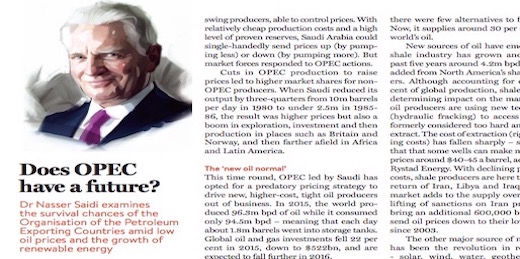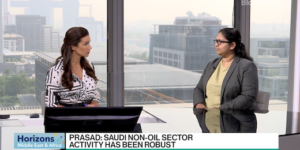This article appeared in the print edition of Gulf Business, April 2016 and is also available at http://www.gulfbusiness.com/articles/industry/energy/does-opec-have-a-future/. Click here to download the print version.
Does OPEC have a future? Opinion Piece in Gulf Business
Will the organisation survive low oil prices and the growth of renewable energy?
With oil prices down by almost 70 per cent from mid-2014, and touching multi-year lows recently, economies across the globe are gradually adjusting to the ‘new oil normal’ and the massive transfer of real income from producers to consumers.
The market has changed radically from the days when the Organisation of the Petroleum Exporting Countries was formed in the 1960s.
Set up with the objective of coordinating and unifying petroleum policies among its member countries to “secure fair and stable prices” and “maintain efficient, economic and regular supply of petroleum”, OPEC is a cartel. The cartel survived (unlike private sector cartels) because it was formed by governments that could acquire and maintain a monopolistic situation. But does it have a future?
For the last 40 years, the Gulf Cooperation Council countries, with the biggest producer Saudi Arabia in the lead, acted as swing producers, able to control prices. With relatively cheap production costs and a high level of proven reserves, Saudi Arabia could single-handedly send prices up (by pumping less) or down (by pumping more). But market forces responded to OPEC actions.
Cuts in OPEC production to raise prices led to higher market shares for non-OPEC producers. When Saudi reduced its output by three-quarters from 10m barrels per day in 1980 to under 2.5m in 1985-86, the result was higher prices but also a boom in exploration, investment and then production in places such as Britain and Norway, and then farther afield in Africa and Latin America.
The ‘new oil normal’
This time round, OPEC led by Saudi has opted for a predatory pricing strategy to drive new, higher-cost, tight oil producers out of business. In 2015, the world produced 96.3m bpd of oil while it consumed only 94.5m bpd – meaning that each day about 1.8m barrels went into storage tanks. Global oil and gas investments fell 22 per cent in 2015, down to $522bn, and are expected to fall further in 2016.
Indeed, Arctic oil exploration has been frozen and globally oil firms have suspended investment of around $380bn. In an attempt to prevent further oil price falls, an agreement was reached in February 2016 to freeze output at January levels. But with Saudi Arabia, Russia and Iraq pumping at close to record levels, the freeze is unlikely to do much to curb the oversupply. Indeed, the structure and dynamics of the oil market has radically changed over the past decade; we are in the era of the new oil normal. What is different this time around?
New energy supplies: Shale and renewables
In its heyday, the market share of OPEC producers was around 50 per cent when there were few alternatives to fossil fuels. Now, it supplies around 30 per cent of the world’s oil.
New sources of oil have emerged. The shale industry has grown and over the past five years around 4.2m bpd have been added from North America’s shale producers. Although accounting for only 5 per cent of global production, shale has had a determining impact on the market. Shale oil producers are using new technologies (hydraulic fracking) to access resources formerly considered too hard and costly to extract. The cost of extraction (rig and drilling costs) has fallen sharply – so much so that that some wells can make money with prices around $40-45 a barrel, according to Rystad Energy. With declining production costs, shale producers are here to stay.
The return of Iran, Libya and Iraq to the oil market adds to the supply overhang. The lifting of sanctions on Iran promises to bring an additional 600,000 bpd and to send oil prices down to their lowest levels since 2003.
The other major source of new energy has been the revolution in renewables – solar, wind, water, geothermal and bio-mass.
Renewable energy has made enormous strides. A record $329bn was invested in clean energy in 2015, despite persistently low oil prices. The forecasts are striking. By 2040, the world’s power-generating capacity mix will have transformed from today’s system composed of two-thirds fossil fuels to one, with 56 per cent from zero emission energy sources.
Renewables will command just under 60 per cent of the 9,786GW of new generating capacity installed over the next 25 years and two thirds of the $12.2 trillion of investment. The cost of solar power has declined by some 70 per cent over the past five years, while modern wind turbines produce 15 times more electricity than the typical wind turbine in 1990.
The bottom line is that renewable energy has become competitive with fossil fuel. Technological innovation is leading to lower costs and there is a growing adoption of renewables in all energy applications; in households, businesses and public uses. Whether increased supply from shale or substitution and competition from renewable energies, these supply side factors all imply downward pressure on oil prices and OPEC’s resources.
Moving to a decarbonised world
Demand side factors are also leading to downward pressure on oil prices.
Emerging market economies enjoyed spectacular growth in the decades from the mid-1980s all the way through to the global financial crisis, almost doubling their contribution to world gross domestic product.
But there is a slowdown in emerging market economies. The International Monetary Fund estimates that, although emerging market economies growth still accounts for over 70 per cent of global growth, economic activity has been subdued in these nations with growth expected at 4.3 per cent this year.
In particular, China, the world’s second biggest economy that had been growing at double-digit rates, has slowed down to below 7 per cent growth – leading to lower growth in demand for oil. In addition, as China rebalances its economy, moving away from energy-intensive heavy industry and manufacturing toward consumption and services (while investing heavily in renewable energy), the previous fuel-hungry nation’s need for oil is on a downward trend.
Energy efficiency and COP21
Two other factors also imply a lower trend in the demand for oil. One is that countries are becoming more energy efficient. Transport, buildings, industry, manufacturing and services are all more energy efficient and industrial applications of energy efficiency can deliver 100 per cent payback in five years.
Organisation for Economic Development and Cooperation energy consumption is now as low as it was in 2000. Despite GDP growing by 26 per cent, energy consumption per capita declined by 9 per cent. Increasingly, countries are decoupling economic growth from energy consumption growth with energy efficiency being the main contributing factor. A similar energy efficiency trend is happening in emerging economies as a result of growing investment in energy efficiency, notably in pollution conscious China.
The second factor is the recent Conference of the Parties 21 agreement promises to peak greenhouse gas emissions “as soon as possible” and to keep global temperature increases “well below” two degrees centigrade.
These COP21 commitments imply gradual decarbonisation, a downward shift in demand for fossil fuels and substitution towards cleaner fuels such as gas, plus new investments in renewable energy, energy efficiency and clean energy generation capacity.
In addition, an energy storage technological revolution is happening. The cost of energy storage (batteries and other forms of power storage) is expected to drop to $100 per kWh in the next five years, against $250 now, to the advantage of renewable energy. In turn, this will favour electric vehicles, with recent research forecasting that EVs will represent up to a quarter of all cars on the road by 2040.
The heralded fourth industrial revolution will be associated with growing energy efficiency and the decarbonisation of our societies and economies. We are living through the end of the oil age.
The new oil normal is the end for OPEC
The new oil normal and its underlying demand and supply fundamentals have permanently altered the structure and dynamics of the oil market.
The oil world that OPEC helped build is defunct. The raison d’être of OPEC has been overwhelmed by structural and technological change and innovation. To quote former Saudi oil minister Sheikh Zaki Yamani: “The Stone Age did not end for lack of stone and the oil age will end long before the world runs out of oil.”
OPEC has a dim future. Shale oil producers are now the marginal producers amid vocal dissension and discord within the cartel as to how to deal with the reality of the new oil normal. Then there is the growing competition from renewable energy in a world facing climate change calamity and increasingly committed to decarbonise. Oil prices are likely to remain depressed over the medium and longer-term.
The future is for decarbonised economies, increasingly reliant on renewable energies. So OPEC should transform itself into the Organisation of Renewable Energy Countries.
The GCC countries should heed the warning of the new oil normal and change strategy over the next decade. They should phase out fuel subsidies, introduce a carbon tax and invest massively in energy efficiency and renewable energy – notably solar – to become global centres of research and development, production, export and finance in relation to renewable energy.






